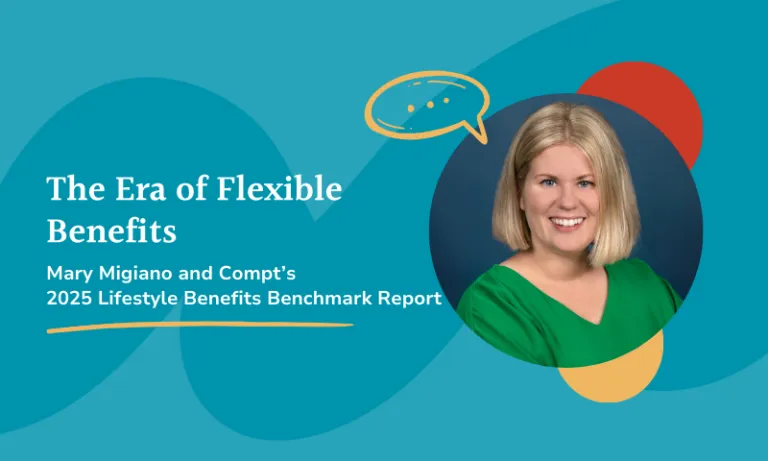According to a report from the Council for a Strong America, lost earnings, productivity, and revenue stemming from childcare challenges cost employers and employees an estimated $122 billion last year. The issue for employees is two-fold: working parents struggle with finding childcare assistance and paying exorbitant childcare costs. There are steps you can take as an employer to help with this, first by offering childcare benefits for employees.
Why? According to Care.com’s 2024 Cost of Care Survey, parents spend an average of 24% of their household income on childcare.

Meanwhile, these childcare challenges impact the workplace by increasing employee stress, reducing employee productivity, and hindering work-life balance. As a result, the overall well-being of employees greatly suffers.
However, by implementing childcare benefits, human resources professionals can help alleviate this growing burden for many families.
In this post, we’ll cover:
- What are Childcare Benefits?
- Types of Childcare Benefits
- Why You Should Offer Childcare Benefits
What are Childcare Benefits?
First, let’s get a definition out of the way:
Child care benefits are employer-provided resources or programs that support employees with child care needs. They help working parents find, afford, and manage child care services during the workday.
The Bureau of Labor Statistics reported that as of March 2024, 14% of full-time private industry workers and 8% of part-time workers had access to employer-provided child care benefits.
But they’re growing in popularity, fast. Care.com’s 2024 Future of Benefits Report revealed that 56% of companies said they were prioritizing them in the latter half of the year and beyond (up 10% from 2023).
The U.S. Chamber of Commerce Foundation found that nearly 60% of working parents blamed their departure from the workforce during the pandemic on their inability to find childcare services. More than a quarter (26%) quit their jobs because they could not afford to pay for such assistance. Considering that many women are the primary caregivers in their families, responsible for elder care and/or taking care of children, it’s no surprise that as many as two million American women left the workforce in 2020.
At the same time, women represent 47% of the nation’s employees. So, companies had no choice but to help these desperate employees find accessible and affordable childcare centers or other childcare providers. Perhaps the increase in these highly desired benefits is why women are returning to the workplace at a higher rate than their male counterparts, as reported by The Washington Post. After all, 46% of companies told Care.com that they’re prioritizing benefits, perks, and services that support employee’s children much more in 2023.

Types of childcare benefits for employees
Childcare subsidies
States give financial assistance to eligible working parents or parents attending school through a childcare subsidy, which the federal government funds. Depending on each state’s specific criteria, a childcare subsidy can help cover the cost of in-home care and/or attending a childcare center.
Employers may also provide childcare subsidies, such as daycare tuition reimbursement, to financially support employees struggling to cover their children’s care expenses.
Since 2001, the Internal Revenue Service (IRS) has rewarded such businesses with an annual tax credit of up to $150,000. The IRS stipulates that the Employer-Provided Childcare Credit is “25% of the qualified childcare facility expenditures, plus 10% of the qualified childcare resource and referral expenditures paid or incurred during the tax year.”
Such qualified expenditures include:
- Qualified child care facility expenditures: This includes costs for acquiring, building, or expanding a qualified child care facility, along with expenses for employee training, scholarships, and higher compensation for trained child care staff.
- Qualified resource and referral expenditures: Payments for employee child care resource and referral services are qualified expenditures.
- Qualified child care facility requirements: Facilities must follow state and local laws, including licensing, allow enrollment for employees’ dependents, and primarily provide child care assistance.

On-site daycare
Between 1991 and 2024, the average cost of daycare and preschool has risen 263% — nearly double the pace of overall inflation. If you have the infrastructure to support it, on-site daycare serves several benefits:
- It eases separation anxiety for working parents.
- It mitigates tardiness and absenteeism due to child care responsibilities.
- It makes infant care (e.g., breastfeeding) more manageable for new mothers.
- It instills a sense of community and familial support among employees.
And, if you own the facility, it provides an opportunity to utilize the employer-provided child care credit.
Family stipends
A family stipend, or family allowance, is a sum of money given to workers in addition to regular wages to help them pay for family-related expenses, such as childcare. Compt, a 100% IRS-compliant reimbursement platform, allows companies to offer inclusive, personalized, and flexible compensation and benefits programs, which include family stipends. According to Compt’s 2024 Lifestyle Benefits Benchmarking Study, the family stipend category jumped to a top 3 category when looking at the amount of money spent.

Paid family leave
The U.S. is the only industrialized country in the world that doesn’t guarantee paid family leave. Instead, the Family and Medical Leave Act (FMLA), passed only 30 years ago, requires companies with 50 or more employees to provide up to 12 weeks of unpaid, job-protected leave per year.
In fact, only Washington, D.C. and 13 states have enacted legislation requiring companies to pay workers during family and medical leave. Those states are:
- California
- Colorado
- Connecticut
- Delaware
- Illinois
- Maine
- Maryland
- Massachusetts
- New Jersey
- New York
- Oregon
- Rhode Island
- Washington
As for employers in the rest of the country, they decide whether to offer paid paternity and maternity leave.
Although studies show that it’s better for both parents to be involved in the early stages of a child’s life, there’s been a decline in companies offering these paid leave benefits since the pandemic. According to data from the World Economic Forum, access to paid maternity leave dropped from 53% in 2020 to 35% in 2022. By 2023, BLS reports paid family leave was available to just 27% of private sector workers.
On the other hand, there are companies leading the way and diversifying their paid leave policies to make them more inclusive. In August 2024, the International Foundation of Employee Benefit Plans (IFEBP) reported that the percentage of employers offering paid adoption leave has increased from 27% in 2020 to 34% in 2022 and further to 37% in 2024.
Despite fewer companies offering paid leave, the fringe benefit remains highly sought after by job applicants, particularly young people preparing to start a family. Regarding compensation, employers typically offer employees about two-thirds of their salary while they are on leave.
Flexible spending accounts
Flexible spending accounts (FSAs) allow working parents to place a certain amount of pre-tax dollars from their paycheck into a separate account, which can then be used to pay for dependent care expenses, such as daycare, preschool, after-school programs, and even summer day camps. (Summer school isn’t included.) Dependent Care FSA funds can only be used for children under the age of 13 or for adults unable to care for themselves, which you claim as a dependent when you file your taxes.
In 2025, Dependent Care FSAs have a contribution limit of $5,000 per household and $2,500 for single filers or if married, but filing separately. Unlike other FSAs, dependent care accounts are “use it or lose it:” the IRS doesn’t allow those funds to roll over into a new year.
Backup childcare
Finding childcare at the last minute is a nerve-wracking ordeal, which is why many large companies arrange backup support. If the children have to stay home from school because they’re sick or if daycare shuts down for the day due to an emergency, working parents can request backup in-home care, such as a babysitter or nanny, or even take their children to a backup childcare center that their employer reserves space for, just in case.
Flexible work schedules
Here’s a benefit that won’t cost your company a penny. Flexible work schedules, such as remote and hybrid work, grant employees the freedom to design their workday to best suit their needs. Working from home, for example, allows parents to drop their kids off at school so they can truly focus on their job responsibilities until it’s time to pick them back up in the mid-afternoon.
Why you should offer childcare benefits for employees
Any human resources team striving to cultivate a diverse, equitable, and inclusive workplace must provide benefits that support employees with childcare needs. This will reduce stress for every employee who is a parent, as they will know that their employer truly values work-life balance.
As a result of easing your employees’ daily stress, facilitating a better work-life balance for them, and making it easy for them to manage work and child care responsibilities simultaneously, you’ll see tons of benefits:
- Higher engagement
- Lower absenteeism rates
- Lower rates of voluntary turnover
- Morale and productivity improvements
- Fewer instances of burnout among working parents
- Greater loyalty to both the company and its leadership
- Easier recruitment (top talent wants to work for family-friendly companies)
For the company, these benefits come with a huge financial advantage as well. According to new research from Boston Consulting Group, child care benefits produce returns of up to 425% of their cost.
And don’t forget the tax benefits of subsidies and FSAs. These accounts favor the employee and the company by reducing taxable income for workers and the Federal Insurance Contributions Act (FICA) and payroll taxes for businesses.
Childcare is a key way to support your people
Offering childcare benefits for employees can positively impact all segments of your workforce. Every employee with kids—from newborns to preschoolers to college-bound parents—will appreciate the company’s support. The morale boost will ripple throughout the company, even uplifting the spirits of employees without children.
Providing benefits that assist with childcare needs and expenses is a worthwhile investment in 2023 and beyond. With the line between work and home blurring more than ever, employees must be able to trust that their employer will have their backs when they need it most.
Looking to offer a tax-compliant childcare stipend to your employees?
Successful companies cater to employees holistically, improving their professional and personal lives.A childcare stipend can be an incredible first step to help support your employees where they need it most.
With Compt, you can offer a recurring, tax-compliant childcare stipend to your employees. To learn more, schedule a customized demo with us today.
Editor’s Note: Compt software supports the categorization and proper reporting of benefits according to IRS guidelines, helping businesses maintain compliance. However, Compt cannot provide tax advice, and users should consult their own tax, legal, and accounting advisors when necessary.
Originally published in 2023, this post has been recently updated for clarity and relevance for our readers.







